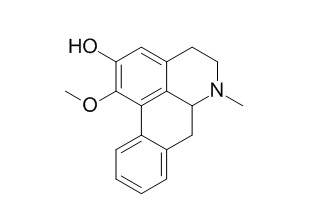2-Hydroxy-1-Methoxyaporphine
2-Hydroxy-1-Methoxyaporphine can inhibit CYP2D6 activity, it also increase the glucose consumption significantly as rosiglitazone.
Inquire / Order:
manager@chemfaces.com
Technical Inquiries:
service@chemfaces.com
Tel:
+86-27-84237783
Fax:
+86-27-84254680
Address:
1 Building, No. 83, CheCheng Rd., Wuhan Economic and Technological Development Zone, Wuhan, Hubei 430056, PRC
Providing storage is as stated on the product vial and the vial is kept tightly sealed, the product can be stored for up to
24 months(2-8C).
Wherever possible, you should prepare and use solutions on the same day. However, if you need to make up stock solutions in advance, we recommend that you store the solution as aliquots in tightly sealed vials at -20C. Generally, these will be useable for up to two weeks. Before use, and prior to opening the vial we recommend that you allow your product to equilibrate to room temperature for at least 1 hour.
Need more advice on solubility, usage and handling? Please email to: service@chemfaces.com
The packaging of the product may have turned upside down during transportation, resulting in the natural compounds adhering to the neck or cap of the vial. take the vial out of its packaging and gently shake to let the compounds fall to the bottom of the vial. for liquid products, centrifuge at 200-500 RPM to gather the liquid at the bottom of the vial. try to avoid loss or contamination during handling.
Plants (Basel).2020, 9(11):1422.
Phytomedicine.2018, 41:62-66
J Korean Med Obes Res.2023, 23:10-7
Journal of Molecular Liquids2021, 334:116014.
Vietnam Journal of Food Control.2022, 5(2): 115-128.
J Neuroinflammation.2023, 20(1):268.
Front Pharmacol.2021, 12:765521.
Int J Mol Sci.2024, 25(19):10660.
Biomolecules.2022, 12(12):1754.
J Breast Cancer.2015, 18(2):112-118
Related and Featured Products
Int J Mol Sci. 2014 Feb 26;15(3):3481-94.
Purification and characterization of aporphine alkaloids from leaves of Nelumbo nucifera Gaertn and their effects on glucose consumption in 3T3-L1 adipocytes.[Pubmed:
24577311 ]
Aporphine alkaloids from the leaves of Nelumbo nucifera Gaertn are substances of great interest because of their important pharmacological activities, particularly anti-diabetic, anti-obesity, anti-hyperlipidemic, anti-oxidant, and anti-HIV's activities.
METHODS AND RESULTS:
In order to produce large amounts of pure alkaloid for research purposes, a novel method using high-speed counter-current chromatography (HSCCC) was developed. Without any initial cleanup steps, four main aporphine alkaloids, including 2-Hydroxy-1-Methoxyaporphine, pronuciferine, nuciferine and roemerine were successfully purified from the crude extract by HSCCC in one step. The separation was performed with a simple two-phase solvent system composed of n-hexane-ethyl acetate-methanol-acetonitrile-water (5:3:3:2.5:5, v/v/v/v/v). In each operation, 100 mg crude extracts was separated and yielded 6.3 mg of 2-Hydroxy-1-Methoxyaporphine (95.1% purity), 1.1 mg of pronuciferine (96.8% purity), 8.5 mg of nuciferine (98.9% purity), and 2.7 mg of roemerine (97.4%) respectively. The chemical structure of four aporphine alkaloids are identified by means of electrospray ionization MS (ESI-MS) and nuclear magnetic resonance (NMR) analysis. Moreover, the effects of four separated aporphine alkaloids on insulin-stimulated glucose consumption were examined in 3T3-L1 adipocytes.
CONCLUSIONS:
The results showed that 2-Hydroxy-1-Methoxyaporphine and pronuciferine increased the glucose consumption significantly as rosiglitazone did.
J Ethnopharmacol. 2014 Apr 11;153(1):190-6.
Identification and characterization of potent CYP2D6 inhibitors in lotus leaves.[Pubmed:
24561383 ]
The herb of lotus (Nelumbo nucifera) leaves is a commonly used traditional Chinese herbal medicine that is utilized for the treatment of sunstroke, to assuage thirst, and to cure both diarrhea and fever in China. Modern pharmacological studies have demonstrated that the herb exhibits various pharmacological effects, such as anti-hyperlipidemia, anti-obesity, anti-oxidant, anti-HIV, anti-microbial, and anti-hypoglycemic activities. Currently, the herb is becoming more popular in China as a "tea drink" or as a main ingredient of some herbal formulations, which implies that the herb and/or its products are now more likely to be concurrently administered with conventional medicines for losing body weight and reducing blood lipids. However, its potential inhibitory effect on human cytochrome P450 (CYP) has not been systemically investigated to date. The present study was performed to assess the potential inhibitory effects of lotus leaf alcoholic extract (LAE), its major fractions, and its main compounds on five CYP isoenzymes (CYP2C9, CYP2C19, CYP2D6, CYP2E1, and CYP3A4) in vitro.
METHODS AND RESULTS:
Five probe substrates were incubated with human liver microsomes in the presence or absence of the LAE, the alkaloid fraction (AF), the flavonoid fraction (FF), or the individual aporphine alkaloids, namely, nuciferine (NF), N-nornuciferine (N-NF), and 2-Hydroxy-1-Methoxyaporphine (HMA). After the incubation, the relative metabolites of the substrates were analyzed using LC-MS/MS.
The results showed that the LAE strongly inhibited CYP2D6 with an IC50 value of 12.05µg/mL and weakly inhibited other isoenzymes. In addition, FF was found to weakly inhibit CYP2D6, whereas AF exerted a markedly higher inhibitory effect on CYP2D6 activity with an IC50 value of 0.96µg/mL. The three aporphine alkaloids isolated from the AF (NF, N-NF, and HMA) significantly inhibited CYP2D6 with IC50 values of 3.78, 3.76, and 3.15µM, respectively. Their Lineweaver-Burk plots and Dixon plots showed that NF, N-NF, and HMA competitively inhibited CYP2D6 activity with Ki values of 1.88, 2.34, and 1.56µM, respectively.
CONCLUSIONS:
The study revealed that the alkaloid compounds in lotus leaves exert a potent inhibitory effect on CYP2D6 isoenzyme. The possible drug interactions of the leaves and their preparations with conventional medicines should thus be taken into account.



